CHAPTER XVI - Summertime - Part I
In the summer of 1992, several evening expeditions were made to some
very inaccessible parts of the park. The price of admission was heat,
humidity, bugbites, fire ants, and catbriar, but the show was worth it.
One of the expeditions was along a wooded trail that went north from
the parking lot rather than south. Most of the trees and shrubs were
the same, but we found some different herbs. Fall is the season for
composites, such as this Gayfeather (Liatris squarrosa).
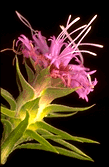
Liatris is unusual in that it sets all of its flower buds and
then blooms backwards down the stem. Most species are some shade of
pinkish-purple....
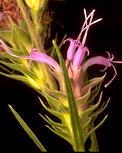
....But some are whitish. Liatris elegans bears pale flower
stalks up to 3 feet tall.
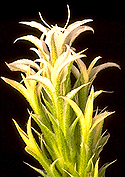
This Button Snakeroot (Eryngium hookeri) is superficially
similar, but is actually a member of the Carrot Family. All of its
leaves and bracts are spiny.
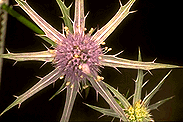
One lucky find was this Butterfly Pea (Clitoria mariana). It
twines on sturdier plants in shady spots. The corolla can be up to 3 cm
long.
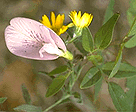
Blue Sage, Salvia azurea, is a fall-flowering mint. The
corollas and calyxes are both bilabiate.
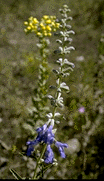 .....................
..................... 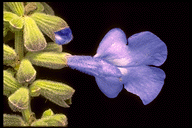
At one point, the trail joins an old road, all damp and overgrown and
shady. Enormous Brown-eyed Susans line the path.
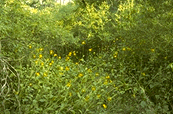
This species, Rudbeckia grandiflora, is up to about 4 feet
tall--much taller than the more common Rudbeckia hirta.
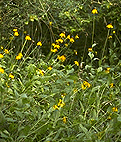
This is Rudbeckia hirta. Note the maroon coloring at the base
of the ray flowers. This species is rarely much more than 18" tall and
flowers spring to fall.
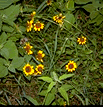
One plant that really likes the damp environment is St. Andrew's Cross,
Hypericum hypericoides.
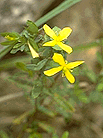
Members of the genus have four golden yellow petals and four
sepals--two large outer ones and two very small inner ones.
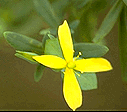
Mistflower or Blue Boneset (Eupatorium coelestinum) likes it
damp also. Where the path crossed a small drainage, there were so many
blue flowers that the area looked like a pool of water.

The showy part of Eupatorium flowers is the long style
branches. This particular Eupatorium looks very much like the
cultivated Ageratum.
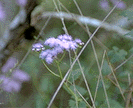
None of the local species of Lobelia is very common, but we did
find quite a bit along the old road.
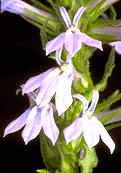
Goldenrod (Solidago canadensis) signals the end of summer and
the beginning of fall. Wherever there is an opening in the canopy,
Goldenrod flourishes.
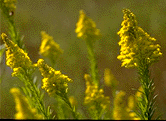
Ironweed, Vernonia texana, is another sign of impending autumn.

The flowers look like pinkish-purple tassels.

All that's left of this Bidens is a cluster of achenes. Each
has a pappus of barbed awns. These will cling to just about anything,
hence the common names Beggar-ticks and Bur-marigold.
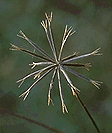
Peppervine, Ampelopsis arborea, is a member of the Grape
family. It will have small, grape-like berries, which unfortunately are
not edible. It has a very superficial resemblance to Poison Ivy but has
many leaflets per leaf instead of three.
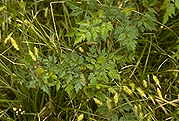
This path eventually leads to the right of way. What was always thought
a dry, barren stretch proves to have at least one damp spot. A huge
patch of Meadow Beauty, Rhexia mariana, bloomed in July. This
member of the Melastomataceae is only found in damp areas and is
usually associated with bogs.
 ...............
...............
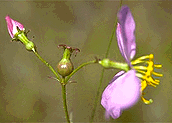
Several specimens of Indian Plantain (Cacalia) bloomed at the
boundary between the Desolation and the woods.

The flowers of Cacalia are not very showy individually,
being sort of a dirty white and lacking ray florets.
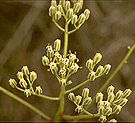
Paspalum urvillei grows to about five feet on either side of the
right of way. Although the common name is Vasey Grass, it was promptly
dubbed "Moses Grass" because it had to be parted like a wall of water
to the right and to the left to allow passage.
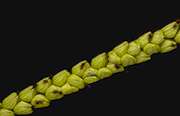
Only impending darkness could drive us from the park.
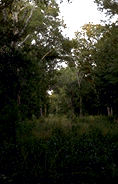
Chapter 17 - Summertime Part II
Lick Creek Park Field Trip Home Page